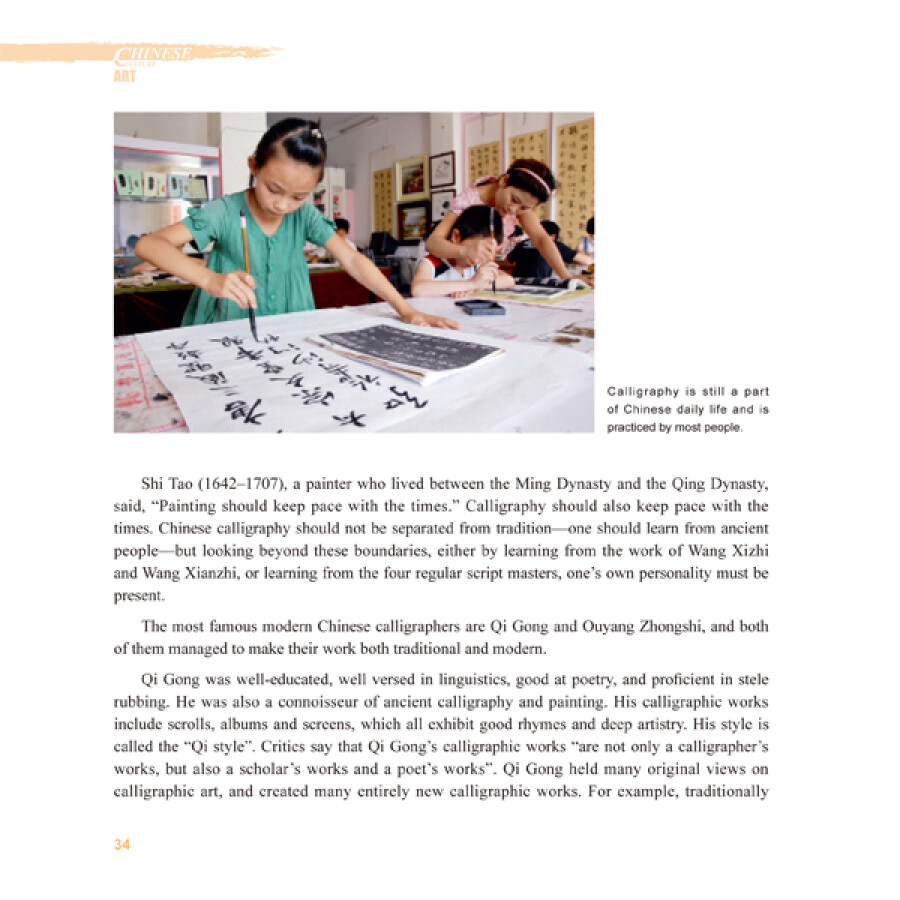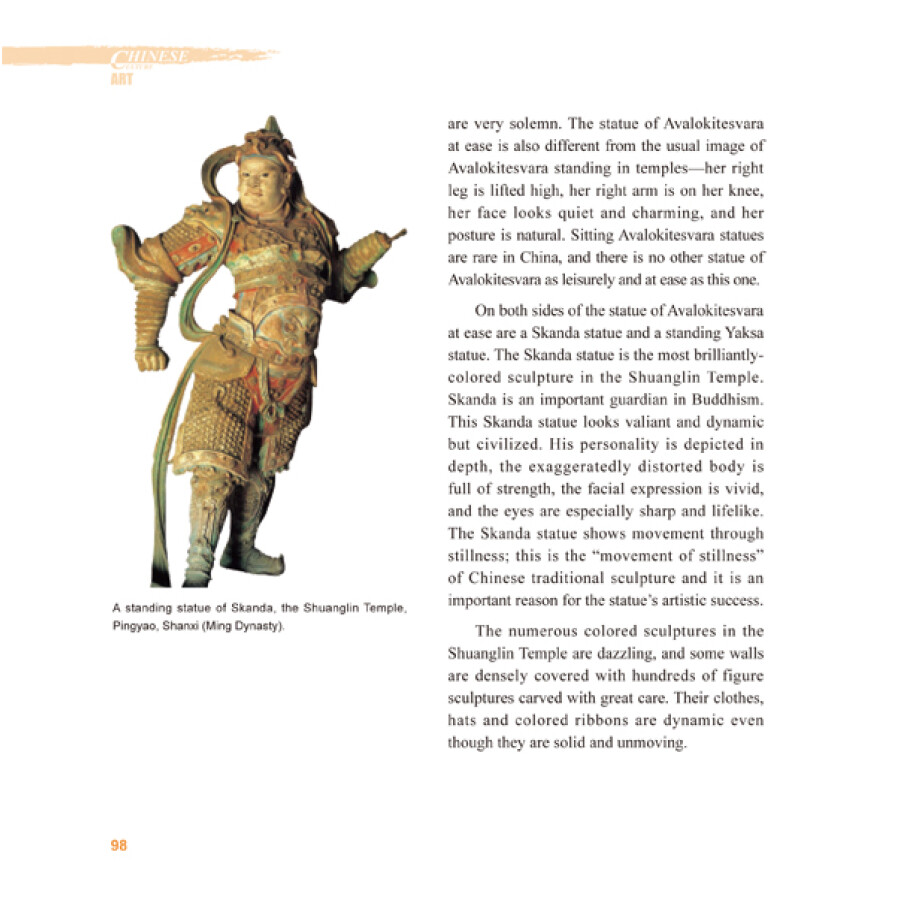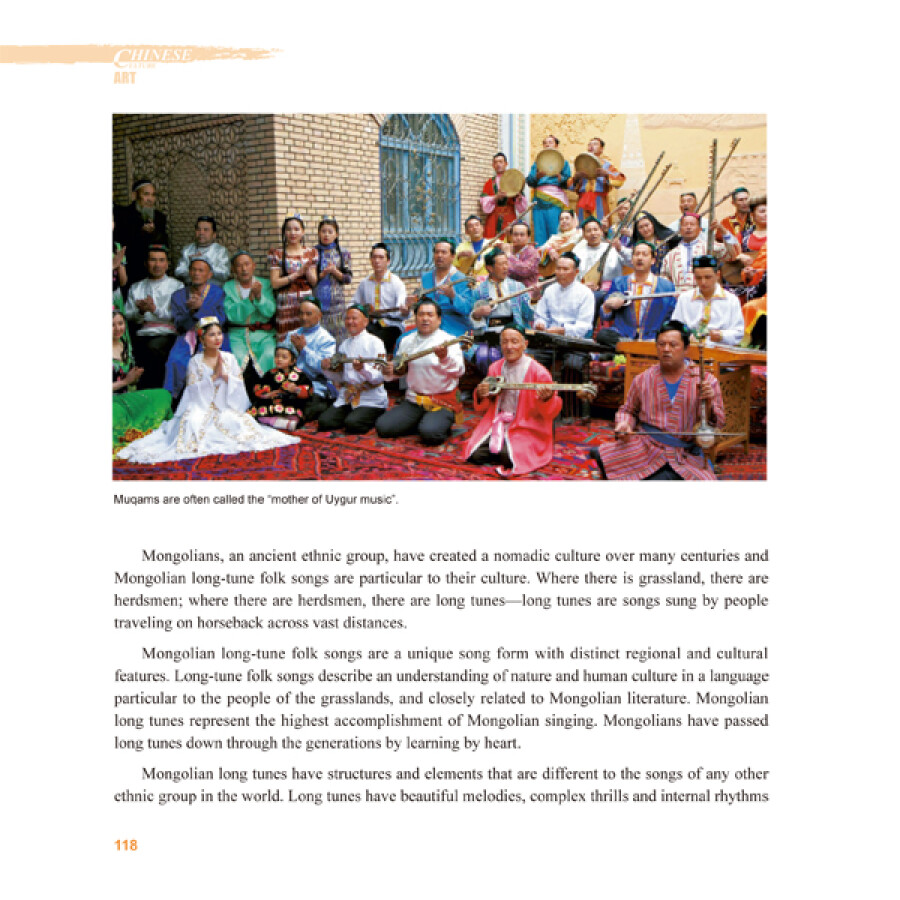Starting from six fields, namely calligraphy, painting, sculpture, music, dance and drama, this book briefly introduces the general development of Chinese art in all ages and focuses on the introduction of the most important art works in various fields. Meanwhile, the book summarizes some distinct characteristics of Chinese art in the comparison with the similar western art.
Contents
Preface
Calligraphy: Writing as Art
Unique Chinese Characters
The Four Treasures of the Study
The Sage of Calligraphy and the Best Running Script Work in the World
The Four Regular Script Masters
Unrestrained Cursive Script
Traditional Calligraphy and Modern Life
Painting: Silent Poems in Praise of Nature and People
Unique Chinese Painting
Depicting Both Ancient and Contemporary Figures
Elegant Ladies
Expressing Feelings through Mountains and Rivers
Flowers and Birds
Along the River During the Qingming Festival
Changing with the Times
Sculpture: Three-dimensional Art
Oriental Charm
Ancient Bronze Sculptures
The Terracotta Army
Buddhist Statues in China
Public Sculpture
Music: Sound for the Soul
Music and the Mind
Traditional Stringed and Woodwind Instruments
Ancient Tunes
Ethnic Music
Singing Aloud: Popular Songs
Chinese Musicians in the Modern Age
Dance: The Beat of Life
When Singing Is not Enough, People Dance
Ceremonial Dance
The Golden Age of Dance
Folk Dance
Dances from Nature
Dance that Celebrates Life
Drama: A Big World on a Small Stage
An Ancient Art
Chinese Drama: from Birth to Maturity
The Elegance of Kun Opera
Beijing Opera
From Greek Drama to Chinese Huaju
Ancient Bronze Sculptures
In 1986 two sacrificial pits were excavated at an ancient site in Sichuan called Sanxingdui. Ancient people in Sichuan offered sacrifices to the gods of nature, heaven, earth, mountains and rivers on this site and rare treasures were unearthed: more than 1,000 ancient utensils, including bronze vessels, items made of jade, and gold vessels, were piled up in the pits, all dating back to the late Shang and early Zhou dynasties.
Other spectacular archeological finds from Sanxingdui include a standing figure in bronze, sculptures of heads in bronze, and bronze masks. Before the excavations at Sanxingdui archaeologists thought that no bronze figure sculpture took place in China before the Zhou Dynasty but these discoveries changed this assumption.
The bronze standing figure sculpture from Sanxingdui is complete and is 182 centimeters tall, with a base of 80 centimeters. Because of the height of the base, the viewer must look up to the figure, which is sublime and solemn: it has two large eyes, a straight nose, a square lower jaw and two big ears, and wears a long robe with buttons to the left on the forepart and anklets. The sculpture provides scholars with valuable information about the look and clothes of ancient people in Sichuan. The figure’s overcoat is neatly carved with dragon patterns, unusual beasts, clouds and mountains. According to The Book of History, dragons, animals, the sun, the moon, mountains and other images were usually featured on ancient rulers’ clothes, banners and flags, implying that the bronze figure represents a person of the ruling class.
Apart from the bronze standing figure sculpture, most of the bronze sculptures unearthed from Sanxingdui were head sculptures or masks. The facial features of these head sculptures are very particular, with exaggerated eyes and ears. Located at the most important positions on the heads, these features are much bigger than real eyes and ears. The heads can be grouped into two types: bony faces, which look solemn and cold, and round faces, which look mild and friendly. Incredibly, bronze head sculptures wearing gold masks were found, together with gold staffs—which begs the question, were the ancient people of Sichuan natives or immigrants? No similar gold find has been located elsewhere in China, but these gold objects are remarkably similar to ancient Egyptian artifacts.
There are also some large bronze masks amongst the sculptures of Sanxingdui, which look like both humans and beasts, or may be gods. The biggest of these masks is 65 centimeters tall, and the ears are 138 centimeters apart. The two eyes look far ahead and two halberd-shaped ears perhaps signify “clairvoyants and clairaudients”, capable of watching and listening in all directions. Another mask is smaller but more unusual: it has a forehead ornament in the shape of a Kui dragon, which is 68 centimeters tall. Some researchers think that this is an image of Cancong, the earliest ancestor of the ancient people of Sichuan. The mask’s exaggerated facial features may symbolize Cancong’s superhuman abilities, or his resourcefulness.
Other types of bronze sculptures were unearthed at Sanxingdui, which also have peculiar and mysterious shapes.
There is a bronze tree almost 4 meters in height (395 centimeters). This astonishing object is thought to be a sacrificial utensil capable of linking earth and heaven, capable of communicating with the gods. This “divine” tree consists of several sections, including a thick trunk and a ribbon base. Archaeologists think that it used to include a big iron bird. The surviving tree has three levels and three branches, complete with fruit and birds, extend from each level. There are records of divine trees in ancient books— for example, the “huge mulberry tree” in The Classic of Mountains and Seas refers to a massive legendary tree beyond the sea, where the sun rises. In terms of cultural meaning, this huge bronze divine tree is perhaps more peculiar. Laozi said in Tao Te Ching: “The way begets one; one begets two; two begets three; three begets the myriad creatures.” This divine tree’s trunk consists of three levels and nine branches and “nine” is consistent with ancient views of the divine. The presence of a climbing dragon beside the tree symbolizes the vast universe.
A bronze sun wheel is another of the mysterious objects found at Sanxingdui. For human beings, the sun is the most important celestial body in the universe. The sun has been worshipped throughout human history. The ancient Chinese worshipped their ancestor the Yan Emperor as the sun god, and in ancient Greek mythology the sun god is the King of the Gods. The sun wheel from Sanxingdui is related to sun worship, which was a particularly important aspect of this agricultural society. The wheel is evenly divided into five parts. Ancient people appreciated symmetry for its beauty and simplicity. For example, a gold ornament in the shape of a sunbird from the Jinsha Culture, contemporary with the ancient Sanxingdui culture, emits 12 rays. Dividing a circle into five even parts was very difficult before modern measuring techniques, so why did the ancient people of Sichuan pursue complexity instead of simplicity? Perhaps we can find clues in the Jinsha sunbird. Its 12 balanced, flowing and rotating rays and four symmetrical totem sunbirds are stunning, but this design is not merely decorative; this divine object is invested with the fundamental properties of the sun—it represents the 12 months and the four seasons of a solar year. These ancient people obviously had a deep understanding of astronomy and calendars, so it may be logical to conclude that the bronze sun wheel might also contain information about the stars and the calendar.
Since the first major archaeological discovery of 1986, more ancient cultural sites and relics have been discovered at Sanxingdui, proving that it was a highly developed society more than 3,000 years ago. The bronze sculptures of Sanxingdui are the highlight of this sophisticated culture.


